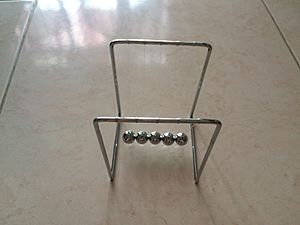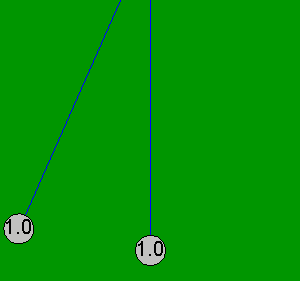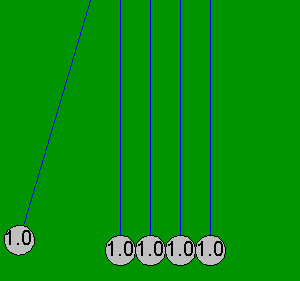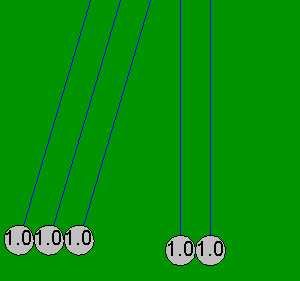Newton's cradle facts for kids
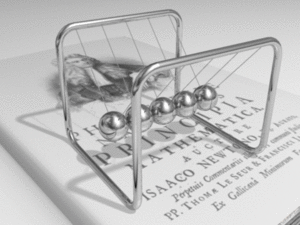
The Newton's cradle is a cool device that shows how momentum and energy are saved, even when things are moving. It uses a row of swinging metal balls. When you lift one ball at the end and let it go, it hits the other balls. This sends a push through the still balls, making the very last ball swing up. Then, that last ball swings back and hits the others, and the whole thing repeats in the other direction!
This device is named after Sir Isaac Newton, a famous English scientist from the 17th century. You might also hear it called Newton's pendulum, Newton's balls, or even an executive ball clicker because of the clicking sound it makes when the balls hit each other. A typical Newton's cradle has several identical metal balls hanging in a frame, just barely touching each other when they are still.
Contents
How it Works
When you pull one of the end balls to the side and let it go, it swings down and hits the next ball. The first ball almost completely stops. But the ball on the opposite end gets almost all the speed and energy from the first ball, so it swings up to nearly the same height! This shows that the energy and momentum from the first ball are mostly passed on to the last ball.
When the first ball hits, it creates a tiny squeeze, or "compression wave," that travels through the balls in the middle. Materials like steel are very good at this because they can store this energy temporarily as they squeeze, instead of losing it as heat. Even though there are tiny movements in all the balls, the last ball gets most of the energy from the first ball's hit. If you drop two or three balls, then two or three balls on the other side will swing out. This amazing behavior helps us understand how momentum and kinetic energy (energy of motion) are conserved in what we call "elastic collisions."
The Science Behind It
The way a Newton's cradle works can be explained using simple math, especially if we imagine the balls only hit each other in pairs. However, in a real Newton's cradle, if one ball hits four balls that are already touching, the movements can be a bit more complex. For example, the fourth ball might move a little, and the first ball might even move back slightly. The animations you often see show an ideal situation where balls only hit in pairs, which happens best if they aren't touching at first.
Simple Explanation
Two important rules in physics help explain the Newton's cradle:
- Conservation of momentum: This means the total "push" (mass multiplied by speed) of the balls stays the same before and after they hit.
- Conservation of kinetic energy: This means the total energy of motion (half of the mass times speed squared) also stays the same before and after they hit.
When two perfectly elastic objects (like the steel balls) that weigh the same hit each other, something cool happens: the moving object almost stops, and the still object takes on all the speed of the first one. This works best when there's no energy lost as heat or sound.
Steel balls are great for this because they don't squish much, and they are very "elastic." This means they don't lose much energy as heat when they hit. This simple idea of two same-weight, elastic objects hitting each other in a straight line is the main reason the Newton's cradle works the way it does.
Imagine you drop two balls to hit three stationary balls. There's a tiny, often unnoticed, space between the two dropped balls. The first moving ball hits the first stationary ball (the second ball hits the third). It transfers all its speed to the third ball and stops. Then the third ball passes the speed to the fourth, and the fourth to the fifth. Right behind this, the second dropped ball does the same thing, hitting the ball that just stopped and continuing the chain. This makes the fourth ball swing out right after the fifth, with the same small gap that was between the two initial striking balls.
Other Examples of This Effect
You can see a similar effect in other places:
- If you slide one coin on a table into a line of identical coins, the last coin in the line will shoot out.
- Billiard balls also show this effect when they hit each other.
- Even in medicine, a similar idea is used in lithotripsy. This is a treatment where sound waves are sent through the skin to break up kidney stones. The side of the stone farthest from the incoming wave bursts, not the side that gets hit first! This is because the pressure wave travels through the stone, and the energy is released at the far end.
When the Simple Explanation Works Best
For the simple explanation to be perfectly accurate, the balls should ideally only hit each other in pairs. If three or more balls are involved in a single collision at the same time, the situation becomes more complicated, and the simple rules aren't enough to predict everything.
Small steel balls work well because they are very elastic and don't lose much energy as heat, even with strong hits. They also don't compress (squish) much, only about 30 millionths of a meter in a small cradle. This means their collisions happen very quickly, in less than 200 millionths of a second. Because of this, steel balls are more likely to finish hitting each other before they touch a third ball nearby. Softer balls would need more space between them to show the same clear "pair-wise" hitting effect.
More Detailed Explanation (Simplified)
In a real Newton's cradle, the balls might not have enough space between them to always collide only in pairs. When this happens, the physics gets a bit more complex, but the main idea of energy and momentum transfer still applies. Scientists use more advanced math to understand exactly what happens when multiple balls hit at once. They think of the balls as having tiny springs on their surfaces. When they hit, these "springs" compress and then push back, transferring the energy.
For example, if one ball hits four balls that are already touching, the energy and momentum are still transferred, but not just to the last ball. The fourth ball might also get some speed, and the first few balls might even move back a tiny bit. This happens because the energy is stored in the squishing of the balls' surfaces during the collision.
Why Steel Balls Are Good
Using different materials for the balls doesn't change the basic action as long as the material is very elastic (springy). The size of the balls also doesn't change the results unless they are so big that they lose too much energy as heat when they hit. Steel is a great material for Newton's cradles because:
- It's very elastic, so it doesn't lose much energy as heat.
- It's heavy, which helps reduce the effect of air resistance.
- It allows the simple explanation of pair-wise collisions to work well most of the time.
Uses of Newton's Cradle
The most common use for a Newton's cradle is as a fun desktop toy. It's also a popular tool in schools to teach momentum and energy conservation in physics classes. A similar idea, about how waves travel through solid objects, was even used in early fighter aircraft to help synchronize the propeller and the machine gun!
Images for kids
See also
 In Spanish: Péndulo de Newton para niños
In Spanish: Péndulo de Newton para niños


